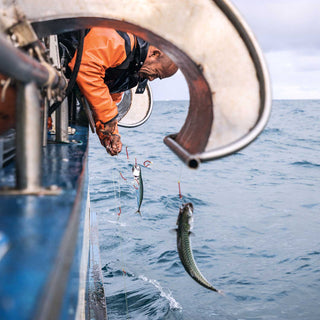Hidden in the earth beneath our feet, billions of microorganisms may help reverse climate change —if we treat them right.
When Politicians argue about the climate crisis, wheat grower Bob Quinn just shakes his head. “Farmers don’t have the luxury to debate climate change,” he tells me. “We have to respond to it.” I’m visiting Quinn at his 4,000-acre organic farm in north-central Montana, an expanse of rolling prairie under a seemingly endless sky, with golden fields of grain and cover crops like sweet clover and alfalfa. He’s had to deal with long summer droughts that can shrivel his plants, and temperature spikes and drops in the middle of winter that can kill the grain in a day. True to his word, Quinn isn’t just throwing up his hands at these new challenges. Instead, he’s using regenerative organic agriculture, which enriches the soil without using chemicals, to ride out weather that has left many of his neighbors with nothing to harvest but disaster payments.
He plunges his hands into the soil, to show me. “There are more bacteria right here,” he tells me, presenting a handful of Montana earth, “than there are people on the planet.” It’s these tiny organisms, several billion in this clump of soil alone, that help support Quinn’s crops and buffer his farm against extreme weather. And he thinks they might just be humanity’s best hope for dodging the climate bullet.
The Soil Builders
Microorganisms matter so much because they’re responsible for creating something called soil organic matter (SOM). It looks like rich, dark soil, and forms when microorganisms break down plant or animal residues—when you build a compost pile, for example, or when plant roots decay underground.
Farmers have long understood that this carbon-rich organic material supports healthy plants, which is why mulching, composting and cover crops have been used for thousands of years. Boosted through these regenerative practices, soil organic matter feeds a constellation of microbes that release nutrients to farmers’ crops. When microbes expire, their bodies further enrich the mass. Soils rich in soil organic matter do a better job of retaining moisture and reducing runoff, while helping to suppress diseases and pests. The key to healthy soil, in short, is soil organic matter, made possible by billions of microorganisms like the ones in Bob Quinn’s hands.
But that’s not all. As climate change worsens, farmers and scientists are increasingly interested in another capacity of soil organic matter: its ability to store carbon dioxide underground. The promise of the soil “carbon sink” is enticing: Globally, soils store about three times more carbon than the atmosphere, most of it in the top meter of soil, which is directly impacted by management. The “4 per Mille” initiative, created in 2015 by a team of scientists from 20 different countries, estimated that a global commitmentto increasing soil organic matter by just four-tenths of a percent could likely sequester enough carbon to offset 20 to 35 percent of the greenhouse gas emissions caused by human activity.

Healthy Soil, Healthy Business
To feed his soil—and its microorganisms—naturally, Quinn alternates between cash crops, like wheat, and nitrogen-fixing crops, mostly legumes like alfalfa. Legumes, Quinn explains, work symbiotically with a bacteria called rhizobia, which colonize their roots. The bacteria absorb nitrogen gas from the atmosphere and convert it into nutrients the legumes can use, a climate-friendly alternative to fossil-fuel-intensive chemical fertilizer. So, as Quinn’s soil microbes feed on nitrogen and carbon from decaying plants, his crops flourish. It’s a win-win.
For Quinn, healthy soils have been crucial not only for healthy plants but also for a healthy business. By using legumes to provide fertilizer, he doesn’t need to buy it. And by building up soil organic matter and maintaining a diversity of crops, he’s also buffering against major losses to drought and climate disruption, which are increasingly prevalent in arid north-central Montana. “With regenerative organic agriculture, we don’t have the highest yields in the county,” Quinn says, “but on a good weather year, we’ll be about at the county average. And in a bad year, we come out ahead. In general, our yields are more stable.” In parts of the world where industrialized farming has not yet completely taken hold—vast swaths of Asia and Africa—he sees the potential for this kind of farming, because it wouldn’t require the capital investment of industrial agriculture. “They already know how to build soils, but growing monocrops for the export market has meant losing some of that traditional knowledge. If they could return to regenerative organic methods like their ancestors used, the research suggests that they’d increase their yields two to three times, long-term average,” Quinn says.
Using Nature as a Model
Meanwhile, in Salina, Kansas, agroecologist Tim Crews is experimenting with another way to help microbes thrive: perennial crops. As a demonstration, he likes to walk visitors from The Land Institute, where he is the director of research, to a little plot of land called the Wauhob Prairie, one of the few remaining patches of intact, original prairie. It’s entirely covered by a dense, thigh-high mixture of perennial grasses, bright yellow sunflowers, purple echinacea, legumes and dozens of other species. “These plants made up the soil that agriculture came to rely on. It’s the ecosystem that we’re trying to live up to,” says Crews.
At the institute, Crews heads up an ambitious effort to breed grain crops that are perennial—meaning they remain rooted in place, rather than being replanted every year like all our cultivated cereal grains, including wheat. Over time, says Crews, annual monocultures have drastically reduced organic matter in many agricultural soils. For weed control, annuals require tillage every year, which can cause soil organic matter levels to plummet. And annuals’ shallow roots and smaller microbial communities don’t add nearly as much soil organic matter to the soil as perennials. “Between tillage and replacing perennials with annuals, we’ve lost 25 to 70 percent of soil organic matter, and chemical fertilizers are a poor substitute for real soil health,” he says.
Crews is also working to grow perennials in mixtures. These perennialpolycultures, he explains, keep a diversity of roots in the ground year-round. In turn, that rich network of roots attracts similarly diverse microbial populations—which build up organic matter, also year-round. With roots continuously in the ground, soil microbial communities can develop more fully and do a better job of stabilizing carbon, keeping it down in the soil for the long term.
For Crews, making good on the promise of truly regenerative agriculture ought to mean restoring agricultural soils to the state they were in before we first started plowing them up, with more than 90 percent of the plants being perennial. “The question is,” he says, “can we make grain function more like the prairie and still harvest something to eat?”

Amy Kumler
Crews’s mentor, Land Institute founder Wes Jackson, began work on this question over four decades ago, and the team just recently released its first commercial crop: a slender, golden, nutty-tasting perennial grain called Kernza®. It first made its way to market in 2016, brewed up into a beer called Long Root® Ale, developed in partnership with Portland’s Hopworks Urban Brewery and Patagonia Provisions. As excited as he is about this deep-rooted edible grain, Crews emphasizes that fields of nothing but Kernza aren’t the goal. Polyculture, with its stimulating effect on microbial diversity, is just as important as perenniality.
As a first experiment, Crews is studying a bicultural system, interspersing rows of Kernza with rows of alfalfa—the same perennial legume that Bob Quinn uses to “fix” nitrogen gas from the atmosphere. The next step, he says, will be to plant the edges of these fields with a flowering crop to attract pollinators and beneficial insects. Silphium, a perennial relative of sunflowers that The Land Institute’s plant breeders are working on, might fit this bill.
But even just the Kernza/alfalfa biculture likely has some impressive advantages over annual monocrop agriculture. Crews is collaborating with Francesca Cotrufo, a soil ecologist at Colorado State University, and her PhD student Laura van der Pol, who are looking at whether combining alfalfa (a nitrogen-booster) with Kernza can increase the amount of stable carbon that forms in the soil—since the mix of nitrogen and carbon favor greater microbial populations.
Another collaborating research group from the University of Kansas, led by post-docs Liz Koziel and Tom McKenna, is exploring whether the balance of microbes in an intercrop system might significantly reduce pathogen spread.
Perhaps the most dramatic finding Crews has made about this Kernza-alfalfa mix, though, is about another potent greenhouse gas associated with agriculture: nitrous oxide. Per molecule, nitrous oxide is 300 times more heat-trapping than carbon dioxide. “Annual cropping systems can lose a lot of nitrogen,” Crews explains. “If you have a period of the year when there are no roots in the ground, no uptake, nitrogen accumulates and tends to migrate either down, into the groundwater, or up, into the atmosphere. Whereas if you have roots that take up nitrogen as it’s being released to the soil in a mineral form by microbes, you don’t tend to accumulate as much nitrate.”
This natural synchrony is exactly what’s happening in the Kernza/alfalfa biculture that The Land Institute is growing for Patagonia, Crews is finding. Kernza roots are taking up nitrogen as alfalfa releases it, so it’s being used as a resource rather than converted into a greenhouse gas problem. Along with colleagues at the University of Minnesota and University of Wisconsin, Crews is now collaborating with nine farmers in Kansas, Wisconsin and Minnesota to grow bicultures of Kernza and legumes and gather more data.
Investing in Soil, Investing in the Future
In a small research plot on his farm, Bob Quinn is also growing Kernza to see how this perennial crop might fare on the northern Great Plains. It’s not yielding large quantities of grain yet, but Quinn is far less concerned with the seedheads than with the root structure.
“There’s two ways to look at a field of crops,” he tells me, breaking down the simple business philosophy that underpins all five of the successful enterprises he’s launched to revitalize his struggling rural community. “You can ask, what are these crops allowing me to take from the land. Or you can ask, what are they allowing me to give back.”
For both Crews and Quinn, building up the soil through their own farming systems—rather than spending energy and money importing organic matter from elsewhere—makes all the difference.
“The thing I realized when I became organic is that no matter how much money I spend, I can never take care of my plants as effectively as the soil does,” Quinn says. “If I try to take care of the plants myself, with fertilizer and herbicides that is, I’m on a constant treadmill, spending more and more money in a losing battle. But if I design my farming system around feeding the life in the soil, that living soil will grow me healthy, resilient plants.”
“It’s just like anything you invest in,” he continues, pointing to a field that’s been under a soil-building organic management system for nearly three decades. The soil there is soft, resilient, springing back a little with every step. “It takes time. You’re not going to see dramatic benefits after your first cover crop or the first year you add more diversity to your crop rotation. But after five or ten years, when the fraction of your soil that is organic matter starts to creep up from one or two percent to three or four percent, this incredible living system starts to take over and do just what it’s always done in nature: sustain itself. The more we can mimic nature, the more successful we’ll be as farmers. With the challenges of climate change—I call it climate chaos—I think this is really our only viable option.”








